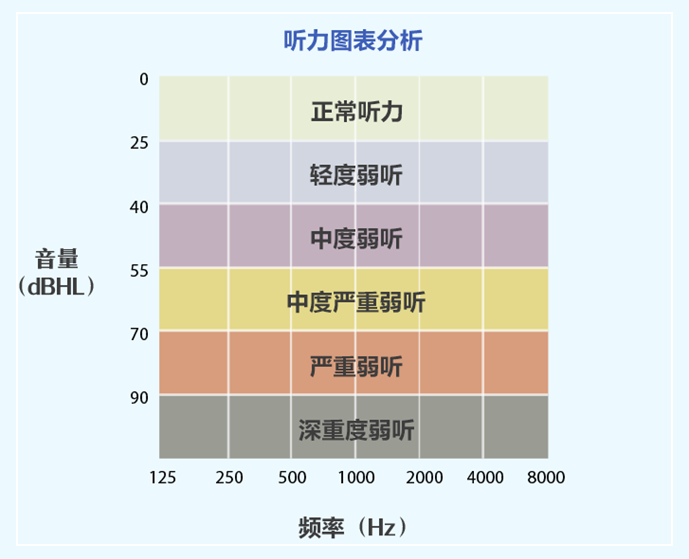Matching Services
If you say “yes” to more than two questions, we suggest you make an appointment with our audiologists for a full audiological assessment and professional advices on rehabilitation.
Types & Causes of Hearing Loss
The ear is a very complex organ comprising three parts: the outer ear, the middle ear and the inner ear. Hearing loss can result from an obstruction or damage to any of these three parts.
Sound transmission process:
 Pinna catches sound waves and directs them into the ear canal. Ear canal carries the sound waves to the eardrum (tympanic membrane).
Pinna catches sound waves and directs them into the ear canal. Ear canal carries the sound waves to the eardrum (tympanic membrane).
 Sound waves cause the eardrum (tympanic membrane) to vibrate. The bones in the middle ear (malleus, incus and stapes) pick up these vibrations.
Sound waves cause the eardrum (tympanic membrane) to vibrate. The bones in the middle ear (malleus, incus and stapes) pick up these vibrations.
 Vibrations pass through the oval window to the cochlea, setting the fluid inside in motion. This causes special nerve cells to turn the sound waves into electrical impulses. The auditory nerve sends these electrical impulses to the brain where they are heard as sound.
Vibrations pass through the oval window to the cochlea, setting the fluid inside in motion. This causes special nerve cells to turn the sound waves into electrical impulses. The auditory nerve sends these electrical impulses to the brain where they are heard as sound.
Ear Structure Diagram

The severity of a hearing impairment is categorized according to how much louder a sound must be made over the usual levels before the listener can detect it. Normal hearing people can hear sounds as soft as 25 dB HL. Hearing level exceeds this normal range is considered as hearing loss. The degree of hearing loss is universally classified into 5 categories: mild, moderate, moderately severe, severe and profound.


Hearing impairment comes from different biologic causes. Type of hearing loss could be classified into 3 types according to the causes: Conductive hearing loss, sensorineural hearing loss and mixed hearing loss.
Conductive Hearing loss
Conductive hearing loss results from an abnormality of the outer or middle ear, which results in a loss of loudness. Some common causes include infection in the middle ear, perforated ear drum, excessive ear wax blockage and otoscelerosis, etc.
Sensorineural Hearing Loss
Sensorineural hearing loss is caused by damage to the inner ear or hearing nerve, which results in a loss of loudness and clarity of speech perceived. A sensorineural loss can result from virus infection, disease, aging, certain drugs and excessive noise, etc.
Mixed hearing loss
Mixed hearing loss is caused by damage to the outer/middle ear and the inner ear. Typically, sound waves are not conducted efficiently through the middle ear, and once they reach the inner ear the vibrations cannot be picked up or sent to the brain. Therefore, a mixed hearing loss is the combination of a conductive and sensorineural hearing loss.
Solutions for Hearing Loss
The impact of hearing loss varies from person to person. It greatly depends on the degree and configuration of hearing loss. However, hearing loss would, at least to certain extent, results in distorted or incomplete communication which leads to greater isolation and withdrawal. In turn the individual's life space and social life becomes restricted. While for those who are still in the workforce, uncorrected hearing loss has a negative impact on overall job effectiveness, opportunity for promotion and perhaps lifelong earning power.
We would guide you through the following three types of solutions for hearing loss:

Medical Treatment Medication and surgery are recommended for many types of hearing problems, particularly conductive hearing loss. It is always highly recommended to seek medical consultation or hearing evaluation as early as possible once sudden hearing deterioration was noted. Recovery of the hearing loss depends not only upon the early diagnosis of the cause of the hearing loss, but also on the early initiation of appropriate treatment.

If your hearing impairment does not originate from a medical problem, which can be treated with medicine or surgery, a hearing aid evaluation can be performed. Although hearing aids do not provide normal hearing to the user, they can help improve a hearing impaired person's ability to communicate effectively. Hearing technology has seen some incredible advances during the last few years. Digital hearing aids are programmed by audiologists via computers. Complex calculations provide the ultimate flexibility in providing individualized solutions to hearing loss. Adapting to a hearing aid takes patience. The process has to be done step by step, never all at once at full strength. Meanwhile, support from friends and family members are also critical for a successful fitting process.

An ALD is any type of device that can help you function better in your day-to-day communication situations. It can be used with or without hearing aids to overcome the negative effects of distance, background noise, or poor room acoustics. There are basically four types of ALDs: 1) FM Systems; 2) Telephone Amplifiers; 3) Listening & Alerting Device; & 4) TV & Audio Device. To obtain personalized advice on hearing aid and/or ALD, please consult our audiologists.
